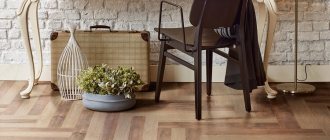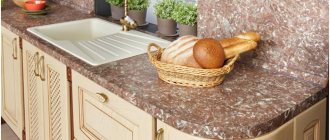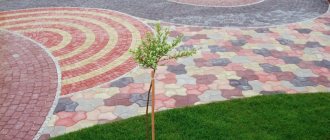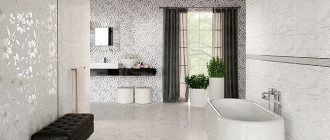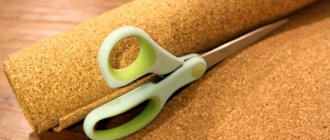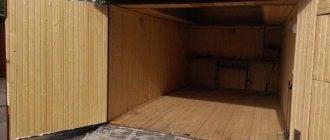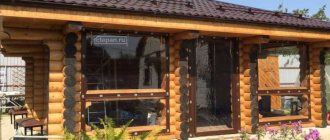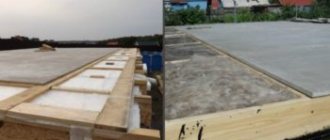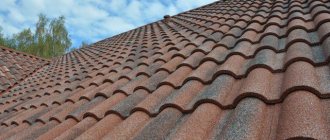The surface of the terrace floor may vary. Floor on the terrace covered with natural wood in most cases requires impregnation, but is not necessary composite board. Surface covered ceramic tiles It gets hot in the sun in summer, cold in winter, but provides an excellent opportunity to uniform the appearance of the floor inside and outside the house.
In turn, a terrace covered with paving slabs visually joins the covering of garden paths made of the same tiles, but is only suitable for above-ground terraces. What material to choose for constructing a floor on the terrace with your own hands?
Coverage Requirements
The general requirements for a DIY house terrace floor are quite simple. Without further ado, these are durability, reasonable price, ease of installation and maintenance, and an aesthetic component. At first glance, everything is quite simple, but it is almost impossible to find a complete combination of all these desired requirements in one material.
The question of how to cover the floor on the terrace with your own hands is very important. But in any case, no matter what material you choose, there are two main requirements - the work must be done with high quality and from high-quality material.
A terrace is essentially a great idea to increase the area of your home. A properly built terrace provides the opportunity to both relax and perform various small chores in the open air.
It is difficult to move on an uneven surface or to arrange the necessary furniture in any way; a slippery floor can pose a health hazard, and a floor made of fragile material means the need for constant repairs and maintenance.
Related publications
Gold paint for decoration: compatibility testing
17/04/2020
Foam glass: disadvantages and thermal insulation properties
29/05/2017
Terraces next to houses without basements are usually built directly on the ground and can have different designs. You must remember that not every type of material can be applied to a specific deck design.
What you need to work with porcelain tiles outdoors
To lay porcelain stoneware on the floor, as well as on vertical surfaces outdoors, you need to prepare:
- a sufficient amount of tile adhesive and grout for joints - frost-resistant and moisture-resistant compounds are required, the packaging of which is marked “for external use”;
- mixture for preparing and leveling the surface for tiles and filling expansion joints;
- compositions (building mixtures) for priming and waterproofing;
- tile cutter (manual or electric);
- hydraulic level;
- equipment for preparing glue - a container, a special mixer or a regular drill with an attachment;
- roulette;
- tools for manual work - spatulas, trowels or trowels, brushes and rollers for priming;
- leveling systems (SVP) or crosses for setting gaps;
- sponges for wiping off mixture spilled on porcelain tiles.
Attention: If you are planning to finish over reinforced concrete, choose adhesives with a high content of elasticizing components - it will help maintain an even coating when the base shrinks.
Terrace planning - location, shape, purpose
The location, size and shape of a deck are critical to its functionality. If you decide to build a terrace, keep this important point in mind. Already at the stage of designing a house, it is necessary to plan a certain space for it.
The shape of the building structure has a significant impact on the footage or location of the terrace. Ideally, the terrace is located next to the kitchen, dining room and living room. In the living room, as a rule, a terrace is planned in the recreation area, for example, overlooking the garden or flower lawn.
The installation of a terrace floor made of natural or composite boards goes well with natural colors.
Thus, most terraces are located at the back of the house, or on the sides of the house, in the south or southwest.
In the summer, and sometimes at other times of the year, the terrace often serves as a dining room or living room, so its dimensions should be similar to the dimensions of these rooms. If you cannot move freely around the terrace, or sit comfortably in the company of friends, then the terrace itself does not make sense.
Its area should be at least 10-12 m2 - the minimum sufficient space required to install garden furniture for six people. Even if the house itself is planned to be small, it is better to design the terrace as large as possible. The most practical are terraces of simple shape. Individually designed terraces look very impressive, but their finishing is more expensive.
The terrace can be closed or open. If you are a principled lover of the open sky above your head, then there is no question - make the floor on the open terrace. Well, if you are in doubt, then here are a few solid ones FOR a closed terrace, FOR a roof over your head.
Why does a closed terrace outperform an open one:
- You can use the terrace at any convenient time, and not just when the bright sun is shining overhead. Think about how often it rains or snows during the year;
- You don’t have to clean the same snow or sweep away water from the terrace floor;
- The covering of the terrace floor and the furniture on the terrace are not exposed to precipitation and direct sunlight, which in any case prolongs their service life.
Covering the terrace floor with paving slabs
Covering the terrace floor with paving slabs or paving is a fairly convenient, quick and inexpensive option. The construction of a floor from such a material, the so-called dry method, eliminates the need to make a concrete foundation or concrete slab.
You can find information about how the soil is prepared before laying paving slabs, everything about the structure and layers of the foundation for laying paving slabs in the article:
FOUNDATION FOR PATH FROM PAVEMENT TILES. A well-made foundation for laying paving slabs and paving stones is not just a tribute to fashion or an incomprehensible necessity. This is reliability... Read the article
In addition, this coating is absolutely insensitive to changes in temperature and humidity. If manufacturing defects are discovered during the construction of the floor, it is not at all difficult to replace or level an individual tile or even a separate section.
A wide selection of paving slabs allows for an individual approach to any terrace. Manufacturers offer not only simple plain tiles, but also tiles with the addition of granite, basalt, glass, artificially aged tiles, tiles with beveled edges, and so on.
The technology for laying paving slabs on the terrace floor is the same as when laying paving slabs when making garden paths from paving slabs. How to lay paving slabs with your own hands, read the article:
HOW TO MAKE A GARDEN PATH FROM PAVEBES ACCORDING TO ALL THE RULES. A garden path covered with paving stones is a reliable option for its construction. It is important to follow the process of its construction... Read the article
Paving slabs have a variety of designs, which allows you to choose the right option for almost any interior and landscape. If the facade of the house is made of ordinary or clinker bricks, a good solution would be to lay a clinker floor. You can choose different types of tiles, tiles that look like stone - granite, syenite or basalt.
Due to the uneven color and texture of each tile, the surface has a unique character. Modern architecture tends towards simple forms. For example, what's wrong with a simple rectangular terrace with a paving slab floor in shades of gray?
Covering the terrace floor with paving slabs is becoming increasingly popular. Dry technology allows you to quickly and easily achieve the desired result.
When constructing an open terrace, ensure that the surface is tilted at an angle of about two to three degrees from the wall of the house to allow rainwater to drain. After preparing the surface of the terrace floor and leveling it, you can begin laying paving slabs. Fill the gaps between the elements with sifted sand using a brush.
It should be remembered that it is very important to ensure the density of the individual layers of the base - the foundation. Otherwise, this may lead to uneven subsidence of the soil. If the terrace is open, then depending on the properties of the soil and the size of the terrace, it may be necessary to provide drainage.
Option #4. Stamped concrete
This is decorative concrete, the surface of which can replicate natural stone slabs, paving stones, wooden parquet, bricks, river pebbles, and ceramic tiles. Such a surface can be made on raised terraces, the base is a reinforced concrete slab.
Advantages:
- durability;
- strength;
- the ability to imitate any material;
- a solid concrete surface does not allow moisture to seep under the coating;
- ease of care.
Flaws:
- gets very hot in summer;
- when using smooth stamps, the concrete surface may be slippery;
- long installation process.
Stamped concrete is one of the most modern options for obtaining a decorative coating on a terrace. To create a stamped surface, a layer of special concrete is applied to the terrace slab, which is “printed” using polyurethane stamps. After stamping, the concrete surface can look like antique pavement or luxury European paving stones. At the same time, all the properties of concrete (durability, strength, frost resistance) are completely preserved.
Ceramic tiles on the terrace
Ceramic tiles are one of the options for flooring on the terrace of a house, like other options, it has its advantages and disadvantages. Optimal and reliable, in terms of operation, would be to lay the tiles on a concrete platform prepared to all requirements.
Laying tiles is possible on terraces that are off the ground, but in this case a concrete slab in the form of a base is required, otherwise there is no guarantee of the reliability of the coating.
Terraces can be laid with ceramic tiles. This can be the same tile that was used in the house, if it is resistant to abrasion, temperature and non-slip, or tile from the same collection.
Tiles used outdoors must be resistant to frost, abrasion and not slippery. Porcelain tiles have proven themselves well.
It is advisable to decide on the choice of a specific tile before starting work, because the tiles have different thicknesses. This must be taken into account when planning the base if the floor on the terrace and inside the building will be on the same level.
When laying tiles on an open terrace, be sure to control the level of inclination of the plane from the wall of the house, ensuring rainwater drainage.
If you decide to opt for tiles, then this is a good, reliable choice. A variety of sizes, colors and textures allows you to find the option that suits you to the fullest.
High-quality ceramic tiles for terrace floors will not crumble, crack or peel, despite all the tests. But the key to the durability of such a coating will be professional installation using expensive and time-tested tile materials.
Examples of porcelain tile collections for exterior decoration
European manufacturers offer customers fashionable series of high-quality porcelain tiles for outdoor use. We offer you several options that can be included in the list of suitable ones:
- Arizona Concrete by Diesel Living. Porcelain tiles with a stylish imitation of concrete texture and a high anti-slip coefficient, thanks to which installation is possible even in wet areas and humid climates.
- Drops from Wow. Spanish porcelain tiles with a stracciatella pattern attract with their matte surface and design, allowing you to create an elegant home space.
- Allmarble by Marazzi. Italian large-format porcelain tiles with outstanding strength characteristics. To decorate a veranda or balcony, choose a matte option.
- Ardesia by Pamesa. A collection by the Spanish brand for decorating the space around country houses, where stylish minimalism reigns.
- Mystone Ceppo Di Gre by Marazzi. Another collection from the famous Italian brand - with a quartz texture, large format and increased wear resistance.
Covering the house terrace floor with natural wood
Flooring made of natural wood, natural boards for terrace flooring, is the most common option when constructing a terrace, both open and closed types. Most often, with this choice, a columnar or pile foundation is constructed.
Firstly, it is really cheaper, and secondly, the floor of the terrace on a columnar foundation is well ventilated not only from above, but also from below, which significantly increases its service life.
Traditional natural materials are not only comfortable, but also practical. The wooden floor on the terrace harmonizes perfectly with the garden, and its combination with the house is also not a problem, since the facades of modern buildings are often decorated with wood. The floor surface is covered with natural wood, like the deck of a ship - it retains heat, but does not burn.
Wooden roof beams go perfectly with the flooring on an outdoor terrace made of composite or natural boards.
When arranging the floor of the terrace, you can, of course, purchase all the necessary lumber separately in accordance with your calculations.
Another more expensive, but simpler option is to purchase a ready-made system for quick installation at various levels - a decking board complete with beams and all fasteners that allow its installation without visible hardware.
Corrugated decking boards , or decking boards with longitudinal grooves, have become quite popular today There are undoubted advantages: it is absolutely non-slippery, more straight, and has a beautiful appearance.
But, as always, if there is a plus, then there is also a minus - sand, dust, or any other dirt can accumulate in the grooves; such a board retains moisture longer and requires great effort for high-quality cleaning.
When finishing the terrace floor with natural wood, there are proposals to use tongue and groove boards . Very controversial advice. The properties of natural wood are swelling and shrinkage, that is, changes in the linear dimensions and volumes of wood when the content of bound moisture changes.
To put it simply, a tongue-and-groove board fastened groove to groove, under certain humidity conditions, can swell and subsequently change shape when dried out. This is especially true for soft wood species with low density - pine, spruce, fir, linden, cedar and others, if their initial drying is incorrect or insufficient.
Large open terraces covered with natural wood fit perfectly into the surroundings of a country house.
Which wood is best for a deck?
, oak and larch deck boards are ideal . Heat-treated ash boards have low water absorption and high resistance to rot, but are prone to cracking and are therefore not suitable for structural members.
If you're on a budget or just want to make your deck the center of your home, you can use exotic wood decking boards.
What exotic types of wood can be laid on the terrace:
- Teak (teak wood) is a tropical wood. The hardness of the wood is above average. Since the name teak represents several varieties, it is found in areas with different climatic conditions: from humid forests to plains with signs of drought. Grows in Thailand, Laos, India, Indonesia, certain countries of Central America and Africa.
- Bankirai (balau) is a tree from the tropical forests of Southeast Asia. Grows in Indonesia, the Philippine Islands, and Malaysia. Many varieties are listed in the Red Book. The color of Bankai wood ranges from dark brown to light brown, with a reddish tint.
- Kumaru (Dipteryx fragrant) is a tree from the Dipteryx genus of the legume family, growing in the tropical forests of South America, most often in Brazil, Bolivia, Peru and Venezuela. It has an interesting and attractive texture, which is not created by a simple fiber pattern and the visual absence of growth rings. It has a peculiar, pronounced smell. The floor of the terrace of the house turns out amazing.
- Tatachuba is a tree, like the cumaru, from South America, mainly exported from Brazil. The wood of tatachuba is heavy, and its strength, in many respects, exceeds the strength of oak. In its natural state, wood is suitable for directional deformation. Color range: shades of brown with yellow or gold.
- Ipe, also known as “Brazil nut”, or guayacan in English, is the wood of a tree from the Tabebuia genus. The color range ranges from olive-gray, dark red to dark brown, darkening over time under the influence of light. The structure is dense, heavy and very durable. Habitat: South America.
A variety of exotic wood species will allow you to turn any of your desires into reality.
This coating is practically not subject to deformation, does not slip and is pleasant to the touch. But there is no doubt that the cheapest and most common decking option is pine board . Pine, practically the national wood for construction, is a very popular material.
High-quality pine decking boards , dried using appropriate technology, plus expensive impregnation - a smart choice. Saturate the pine board as required, it will serve you for many decades and you will forget to think about exotic wood and the question of how to cover the floor on the terrace.
The floor on the terrace is made of WPC (wood-polymer composite) boards
Today, when building or repairing a terrace, many are increasingly paying attention to the so-called composite board , to be more precise, a board made of wood-polymer composite (WPC). WPC is a product of mixing wood with monomers, with their further polymerization. As a result, at the end we have a product very similar to a natural corrugated board made of exotic wood - even to the touch.
Composite decking is laid on special guides with small gaps between each board.
This terrace floor board is devoid of knots and defects present in products made from natural wood. They are characterized by high strength, geometric stability, are not subject to fading and discoloration, do not require special maintenance and care, just periodic cleaning with water under pressure.
The composite board is fastened using specially designed fasteners, which ensures its complete concealment.
Unfortunately, all of the above positive characteristics apply only to a high-quality board made from expensive materials and in compliance with technology. And, also unfortunately, neither the price nor the country of manufacture is a guarantee of the quality of the purchased WPC decking board.
Considering the high cost of this product, purchase a composite board only based on reviews from real customers from well-known manufacturers and always with a long-term guarantee. Poor quality composite decking fades, comes apart and even behaves like a poorly dried natural board.
High-quality WPC boards can be used not only for covering terraces. It’s not bad at all if the terrace covering is in harmony with the fencing of your home. If you look at beautiful photos of fences for private houses, you will see that using WPC boards to fence the territory of a house is not at all a bad option for the right solution.
Rubber flooring on the terrace
Another common floor covering is coating made from products containing rubber, both natural and synthetic. This coating has a number of advantages and disadvantages.
Products made from rubber are not exposed to the environment, they are not traumatic, like concrete or stone tiles; walking on such a surface is pleasant, comfortable and does not slip. The price category of such products is not exorbitant, and do-it-yourself installation is quite within the capabilities of even a non-professional.
A wide selection of colors for rubber tiles provides interesting opportunities for bright design solutions, which is quite difficult when using natural materials.
Just as in the case of WPC products, you need to be very careful when choosing a manufacturer of rubber tiles. Often, rubber (rubber) tiles for terrace floors are made from processed products of the automobile industry, in other words, from car tires. After processing tires, granulate is obtained, which subsequently serves as the main component for new rubber products.
High-quality rubber tiles enliven the environment, are safe and last for many years.
The quality of the resulting products directly depends on the quality of the components used in their production: dyes, converters, special additives and, of course, on the quality of the base - granulate. Trust only large manufacturers with positive reviews and a long history of production activity.
The best manufacturers
We offer a brief description of the largest and most popular manufacturers of ceramic tiles in Russia.
Keramin
European manufacturing company. It has the largest sales volumes in the ceramics market. Specializes in the production of ceramic bricks, granite, tiles, sanitary ceramics. All Keramin products have registered certificates of conformity, and sanitary ceramics have a certificate of hygienic registration, environmental ISO 14001-2005.
Photo: Keramin tiles
Finished products undergo constant quality control. New equipment has been installed in the workshops, thereby reducing the duration of the technological process and increasing production volumes.
Kerama Marazzi
Domestic manufacturing plant with a wide network of distribution companies. Founded in 1988 in the city of Orel.
Kerama Marazzi produces ceramic tiles and granite, borders, steps, panels, mosaics and other elements. The company's catalog contains over 2000 items.
The quality of products is confirmed by compliance with international, state standards and requirements, and expert opinions. The Marazzi factory also produces many thematic collections of ceramics. Applications for individual orders are accepted.
Stone Age
Russian manufacturing plant. It has been producing paving slabs for more than 12 years. In 2012, the entire production line was re-equipped to European standards. The ColorMix system was introduced to make an analogue of imported clinker. Models of floor slabs with granite, quartz, and basalt chips have been added.
Gothic
Domestic tile manufacturer. The factory was founded in 2005. “Gothic” products are often called mosplite, since many iconic places in Moscow are paved with it (Alexandrovsky Garden, Old Arbat). German HESS equipment is installed in the workshops. The tiles are created using the semi-dry vibration pressing method. Manufactured products are divided into PREMIUM and PROFI classes. The first has a high cost and imitates natural stone in appearance, the second is standard sidewalk tiles in different colors.
What should you choose?
In the end, the choice of one type of coating or another is determined by a number of actually existing factors.
What ultimately determines our choice:
- The first factor is the financial component. If the final cost of the floor is not a fundamental issue for you, you can, of course, recommend a covering made of natural material - exotic wood species prepared for use as a terrace covering, or a covering made of clinker bricks for sidewalks. Otherwise, high-quality pine decking boards with expensive impregnation or standard paving slabs are not a bad alternative.
- The second factor is the spatial position of the terrace. If the floor of the terrace is planned to be level with the ground, then the use of both boards and paving or any type of tile would be justified. If the terrace level is higher than ground level, it is advisable to use natural or composite boards.
- The third factor is the installation process. When covering the floor with your own hands, ready-made custom-made terrace systems are the ideal option. Laying paving slabs as a floor covering also provides an opportunity to correct deficiencies made during work. At the same time, improper fastening or cutting of an expensive decking board made of exotic wood will add additional financial costs and time to the work. In a word, focus on your personal skills and abilities.
Tags
choice of material decking wooden floor composite board floor ceramic tile floor natural plank floor terrace floor terrace paving slabs
Waterproofing rules
The essence of the process: cutting off the screed or heat insulation from moisture. A layer of waterproofing is laid. The materials used are roofing felt, glassine, and special membranes. They are laid from below, under screed or insulation.
Waterproofing is carried out when installing the subfloor. The insulator layer must be airtight, so the installation is done overlapping, and the joints are taped with construction tape. If we are dealing with wooden flooring on a joist system, then waterproofing is only needed at the points where the wood comes into contact with the foundation.
To summarize, we note that there are enough materials for arranging the floor. Which one to choose depends on the features of the veranda, budget and expected result. The classic option is wooden flooring, modern and simple is rubber coating, complex but durable is self-leveling flooring.
